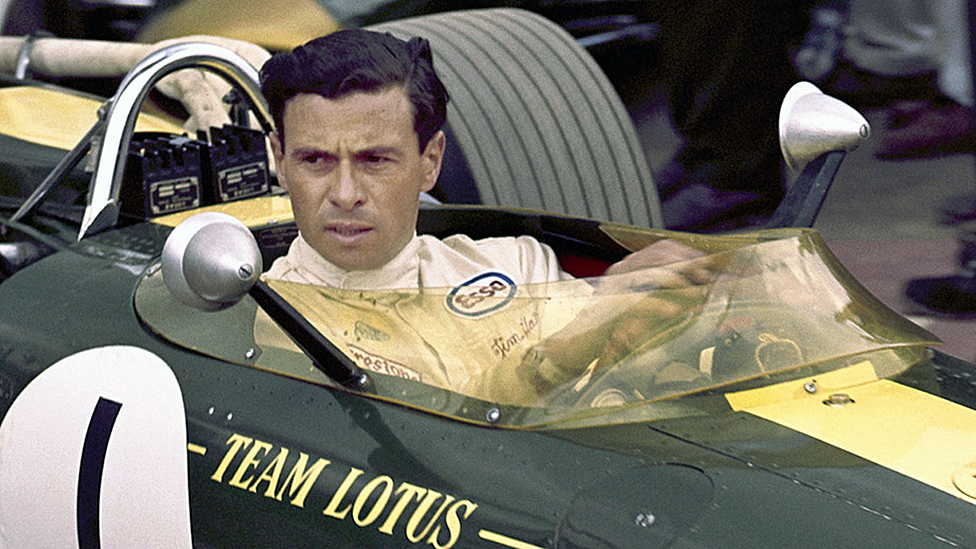In the roaring pantheon of motorsport legends, some names echo with the thunder of engines and the spray of champagne, while others are spoken in hushed, reverent tones. Jim Clark belongs to the latter. For those who witnessed him carve poetry through the apex of a corner in the 1960s, he wasn’t just a racing driver; he was the benchmark, a quiet maestro whose talent was so profound, so innate, that it bordered on the supernatural. He was the shy Scottish farmer who became the most dominant force of his era, a man whose gentle demeanor off the track belied the devastating velocity he commanded on it.

Born in 1936, James “Jim” Clark Jr. grew up on a farm in Kilmany, Fife, a world away from the glamour and danger of international motor racing. His early life was one of rolling hills and rural tranquility, a setting that seemed to instill in him a lifelong humility. But beneath that calm exterior was a burgeoning passion. Clark discovered his calling not in the grand academies of motorsport, but in local club events and rallies in the late 1950s. It was here, behind the wheel of ordinary road cars, that his extraordinary ability first became apparent. He possessed a rare, instinctive feel for a car’s limits, an ability to extract every ounce of performance with a preternatural smoothness that left onlookers astounded.
His meteoric rise from local hero to global phenomenon was catalyzed by one pivotal relationship. Colin Chapman, the brilliant and innovative founder of Lotus, saw in Clark something no one else did: the perfect conduit for his radical, often fragile, automotive designs. Chapman’s cars were notoriously difficult to drive, built on the bleeding edge of engineering with a philosophy of adding lightness until they were just shy of falling apart. They demanded a driver with immense sensitivity and mechanical sympathy. In Clark, Chapman found his muse. Their partnership would become one of the most successful and symbiotic in the history of Formula 1, a perfect union of man and machine that would redefine the sport.
Clark made his Formula 1 debut at the 1960 Dutch Grand Prix, entering a sport in the midst of a technical revolution as teams transitioned to rear-engined cars. From the outset, he looked different. While his rivals wrestled with their machines, Clark seemed to dance with his. His style was a study in fluid dynamics—precise, composed, and deceptively fast. His inputs were so minimal, his control so absolute, that it often appeared effortless. Yet, the stopwatch told a different story. He was, quite simply, faster than everyone else.

The statistics of his career are staggering and speak volumes of his dominance. In just 72 Grand Prix starts, he claimed 25 victories—a win rate of nearly 35% that remains one of the highest in F1 history. He also secured 33 pole positions, meaning he started from the front of the grid in almost half of his races. Astonishingly, many of his defeats were not due to being out-driven, but to the infamous fragility of his Lotus. It is a widely held belief that with more reliable machinery, his records would be even more untouchable.
His two world championship seasons stand as monuments to his genius. In 1963, he put on a display of utter supremacy, winning an incredible seven out of ten races. He didn’t just win; he annihilated the competition, often finishing laps ahead of his closest challengers. He sealed the championship with a victory at Monza, a moment of triumph that cemented his status as the best in the world.
Two years later, in 1965, he did it again. He won six of the ten races to claim his second world title with a similar brand of untouchable dominance. But 1965 was the year Clark transcended Formula 1 and became a global icon. He decided to skip the prestigious Monaco Grand Prix to compete in the Indianapolis 500. At the time, it was unheard of for an F1 star to challenge the American oval specialists on their home turf. Clark, in his revolutionary rear-engined Lotus, not only competed; he delivered a masterclass. He led for 190 of the 200 laps, becoming the first non-American in nearly half a century to win the legendary race. To this day, Jim Clark remains the only driver in history to win both the Formula 1 World Championship and the Indy 500 in the same year, a testament to his incredible versatility.
This adaptability was a core part of his legend. In an era where drivers specialized, Clark raced—and won—in everything: touring cars, sports cars, Formula 2, and the Tasman Series. His ability to jump into any type of machinery and be immediately on the pace highlighted a natural talent that was simply on a different plane. His smooth, fluid style not only made him fast but also preserved his equipment. In an age of mechanical unreliability, his sympathy for the car’s brakes, tires, and engine was a crucial weapon in his arsenal.

Despite his on-track ferocity, Clark remained a profoundly humble and private man. Reserved and shy, he had little interest in the fame and celebrity that came with his success. Between races, he would often retreat to the familiar comfort of his family farm, a quiet sanctuary from the high-octane world he dominated. This quiet humility, paired with his undeniable greatness, earned him the deep and universal respect of his peers. Sir Jackie Stewart, another Scottish legend and a fierce competitor, famously called Clark the greatest racing driver he ever had the privilege to race against.
But Clark’s career unfolded during motorsport’s deadliest era. Safety was an afterthought, and drivers were modern-day gladiators who accepted that death was an ever-present risk. On April 7, 1968, that risk became a tragic reality. During a Formula 2 race at the Hockenheimring in Germany, Clark’s Lotus suddenly veered off the track at high speed and crashed into the trees. Jim Clark, the invincible champion, was killed instantly at the age of 32.
The news of his death sent a shockwave of disbelief and grief through the motorsport world. The quiet champion, the man who seemed to have a sixth sense for control, was gone. His passing was a profound loss that served as a brutal wake-up call, prompting his friend Jackie Stewart to begin a relentless crusade for safety reforms that would ultimately transform the sport and save countless lives.
Jim Clark’s legacy is not just measured in wins and championships. Had he lived, experts agree he would have undoubtedly added many more titles to his name. But his true impact is defined by the reverence with which he is still remembered. He was the driver’s driver, the one who rivals and engineers alike considered to be in a league of his own. He was “the artist” of speed, a man who drove with an elegance and purity that has never been replicated, setting a standard of natural talent that remains the ultimate benchmark in motorsport.
News
Die Sprache der Liebe: Wie Bushido und Anna-Maria Ferchichi ihre 15-jährige Ehe in der Paartherapie retteten – Das emotionale Geständnis der „Liebessprachen“-Krise
Die Ehe von Bushido und Anna-Maria Ferchichi gehört seit Jahren zu den am meisten beachteten Partnerschaften der deutschen Öffentlichkeit. Sie…
Tanzwunder im siebten Monat: Renata Lusin tanzt hochschwanger! Das emotionale Comeback und die bewegende Geschichte des “Campingbabys”.
Die Nachricht schlug in der deutschen Medienlandschaft ein wie ein funkelnder Diskokugel-Blitz: Renata Lusin, die charismatische und stets energiegeladene Profitänzerin,…
Antonia Hemmer enthüllt das bestgehütete Geheimnis: „Er ist derjenige, für den ich gebetet habe“ – Ein Beweis von Liebe, Schutz und Selbstbestimmung
Es war ein einziger digitaler Atemzug, der die gesamte Reality-TV-Welt in ihren Bann zog und die Gerüchteküche zum Überkochen brachte….
Schock-Nachricht beim TV-Comeback: Helene Fischer kündigt Mega-Pause für ihre große Stadion-Tour an!
Die Schlagzeilen über Helene Fischer sind meist ein Spiegelbild von Superlativen: Rekorde, ausverkaufte Stadien, atemberaubende Spektakel. Doch nach der Geburt…
Anna Heiser: „Was sich wie ein Ende anfühlte, war unsere Rettung“ – Die dramatische Wahrheit hinter Ehekrise, Existenzangst und dem radikalen Neuanfang
Wenn Anna Heiser (35) heute mit ihrem Mann Gerald und ihren Kindern Leon (4) und Alina (3) glücklich um den…
Zwischen Blitz-Einsatz und Glamour-Verwandlung: Katja Burkards ungeschminkter Sprint zur Rettung der RTL-Show Denn sie wissen nicht, was passiert
Der Samstagabend ist in der deutschen Fernsehlandschaft traditionell die Hochburg der großen Unterhaltung, der Ort, an dem sich TV-Ikonen in…
End of content
No more pages to load











